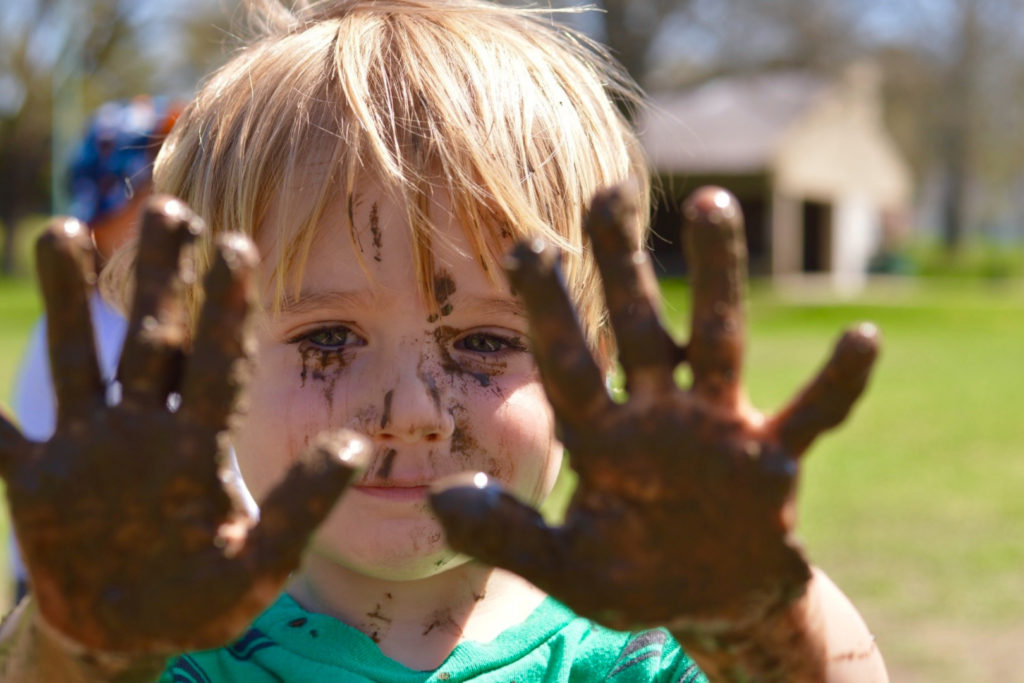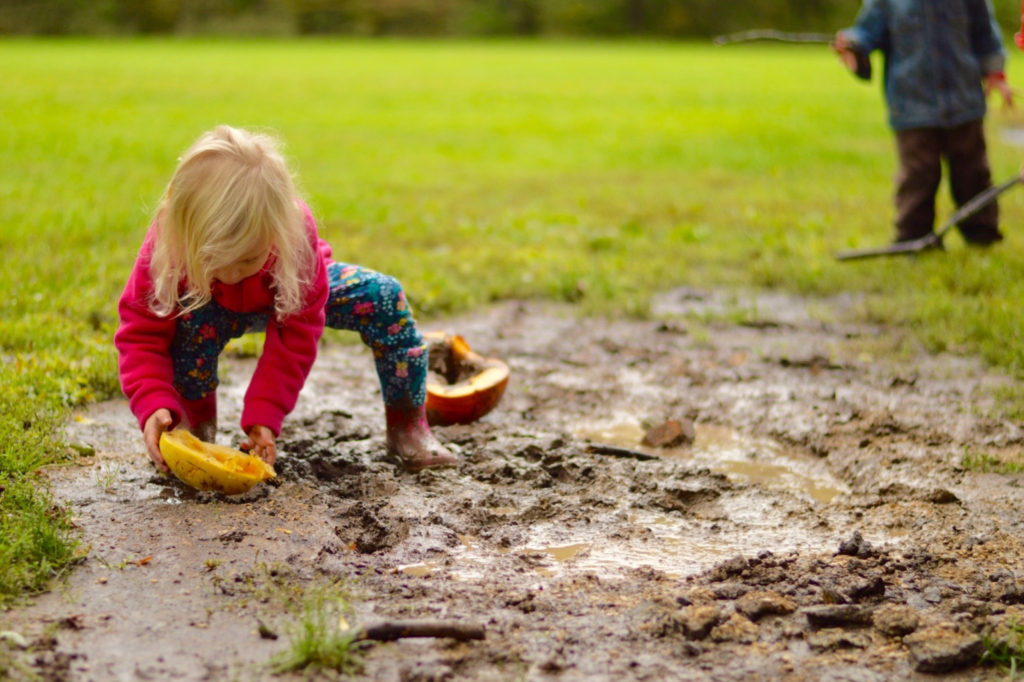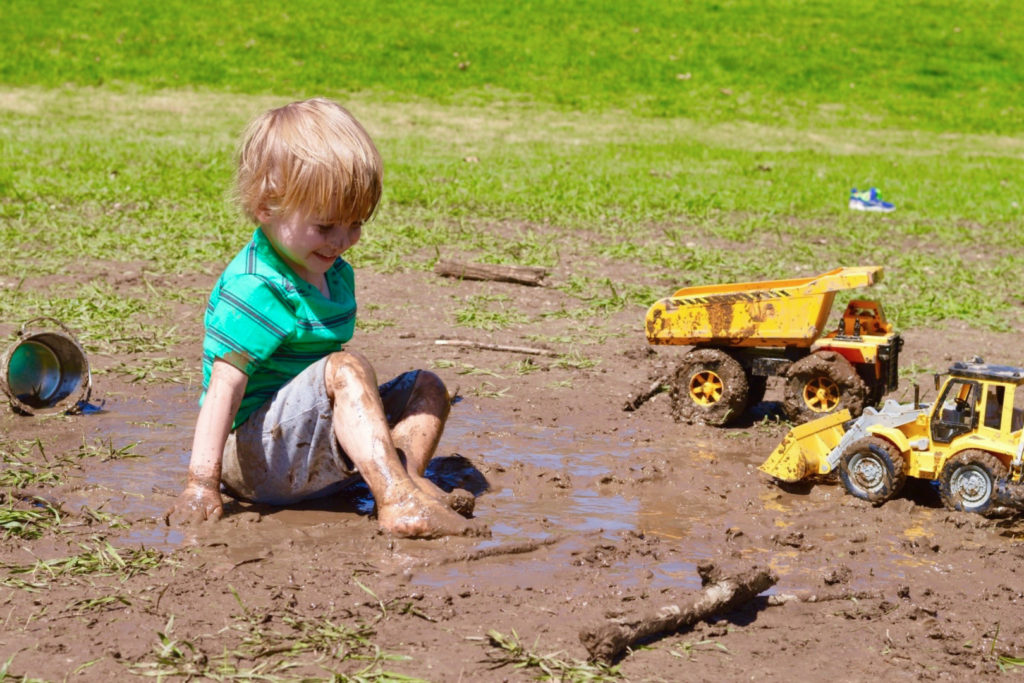
Oooey gooey. Squishy. Smooshy. Goopy. Sloppy. Drippy. Squelch. Oh, glorious mud!
There are so many different types of mud. And so many different ways to play with mud.
I know what you’re thinking: Mud?! Really? Why would I want my kiddos playing in mud?
Allow me to share a few reasons.
It’ll make them happier and healthier.
Science has confirmed that some of the bacteria we are exposed to while playing in the dirt and mud is directly linked to an increase in serotonin production in our brains. The microscopic bacteria in dirt can help our kids — and us grownups, too! — be happier, calmer and more relaxed. It can also improve our immune systems, leaving us healthier and more likely to stay that way.
It boosts creativity.
Our children are faced with more rules, expectations and scheduled activities than any generation before. There are fewer places and less time in their days to get messy, to really allow kids the freedom and flexibility to create, make mistakes and problem solve on their own. We like to say, “Messy play leads to messy (creative) thinking.” And mud and dirt are a great way to dive into messy play. Understanding how to find creative solutions and not being afraid to dig in are important to develop in childhood and carry forward into adulthood.
It leads to improved cognitive function and development.
Did you know that sensory play — especially with natural elements like dirt, water, snow and sand — builds more neural pathways in a child’s brain? Increased nerve connections in the brain lead to a child’s ability to complete more complex tasks. So, allowing our kids to squeeze mud in their hands, splash in the water, lick the snow and throw the sand all lead to improved cognitive function. Mud and other sensory play also promotes development of both gross and fine motor skills, social skills and problem solving.
It’s inclusive.
Children of all ages and stages of development can find a way to play in the mud and dirt. I will never forget an infant sibling of an explorer in one of my classes, desperate to get out of mama’s arms and into the dirt. She ended up completely mud-covered and utterly delighted. Mud day is always a favorite of mine. If my own kiddos are wanting to me to play, mud is always a good entry point for me. And even those children and adults reluctant to get muddy or messy can find a way to play!

Ready to dip your toes in the mud? Here are fun ways to play!
For the reluctant or new mud player:
Start by warming up for sensory play: Wake up all of your senses by listening, smelling, looking and feeling. Rub your hands together. Get them wet in some clean water. Drip some of the water in an area of exposed dirt. Pour, splash, mix and dive in!
For mud players who do not want to get messy or muddy hands, try adding a stick for poking at the fresh muddy puddle. Add more water (you can never have too much water in mud play).
Bring out some paintbrushes and dip them in the mud. Paint the sidewalk. Decorate a tree. Bring out a sheet, or paper or an old canvas.
Invite friends and toys to join in the mud play. Adding trucks, cars and other toy vehicles can be great fun! Some mud players might prefer to stick to cleaning and washing muddy vehicles with clean water and a sponge or cloth. Other toys are great to add to the play, too! Plastic animals, plastic dolls, building blocks and other easily washable toys can help reluctant mud players find a comfortable entry point.
For the excited mud player:
The options are endless for those excited to dig into the mud! Some of my favorites are mud pies and other cooking, making faces in and with mud and digging for worms.
Mud pies are great for all mud players. A more reluctant friend might want to stick to the decorating, while a more excited mud player helps to create, mix and form the mud pies. Mud pies can be simple — a lump on the ground with nature treasures mixed in — or very elaborate. And the mud “food” doesn’t have to stop at pies, of course. Mud cakes, mud meatballs, mud stew, mud pudding, mud pizza, mud dumplings, and the list could go on and on.
Making faces with nature treasures is always engaging. If I start to build a face — in a class, on a hike or just playing outside — I usually have several interested kids come and then offer to help find eyebrows, or a mustache, or a better looking mouth. Nature treasures in the mud or faces made of mud are both such fun!
Taking old bouquets of flowers are a great way to add a lot of pizzazz to mud faces (and all of mud play). Petals can make the edges of faces, or the nose, or forty-two ears. Leaves and stems can make great mouths or wacky hair.
Mixing up building mud to make a 3D face on the side of a tree can keep me occupied for hours. My kiddos love to make faces by throwing balls of mud a tree to see what sticks. And it always ends in giggles when parts of the face fall down splat back in the mud!
“Wormology” — or finding worm friends in the dirt — has so many lessons to offer, from teamwork (see how many worms we can find all together) to empathy (thinking about how the worms want to be treated) to observation (Where are we finding the most worms? How do they move?).

For the dedicated mud player:
If your family falls in love with mud play or wants to dedicate space for regular mud play, building your own mud kitchen is the way to go. It does not take much to build your own mud kitchen, and everyone’s will look different. While there are plenty of lovely, potentially extravagant examples out there, I find it best to keep it simple. Take a few old or thrifted kitchen supplies — muffin tins, pie pans, loaf pans, cookie sheets, cooking pots, a few spoons — and add in some dirt and a water source and you have your very own mud kitchen!
Mud kitchen supplies can live in an easily accessible bin or cart, or have a dedicated structure. Access to other nature treasures like rocks, sticks and plant material really enriches and extends the play. Ensuring everything is easy for kids to get out themselves ensures regular mud play!
If you want to really celebrate your love of mud — or relegate mud play to a single day — International Mud Day is on June 29 each year. Find your way to celebrate! Maybe you build a mudslide. Maybe you find the biggest muddy puddle and see who can make the biggest splash. However you find to play in the mud is the best way to play!
– Lee Alliet
Photos courtesy of Lee Alliet.
Lee Alliet is a Tinkergarten leader, wildschooling mama and outdoor enthusiast. She lives in Wisconsin with her husband, two kids, resident dogs and an array of foster dogs. You can follow her outdoor adventures on Instagram and learn more about classes and events in the Madison area on her website.